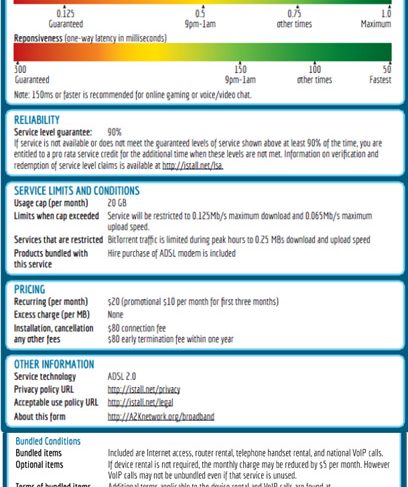
OTTAWA – It’s common these days to see Internet speeds still advertised with “up to” speeds that rarely ever approach the average speeds that subscribers will actually experience in practice. The problem is that most consumers believe they are getting, at least some of the time, the advertised speeds says the Public Interest Advocacy Centre (PIAC) because they are not being properly informed. It’s calling on the Competition Bureau and CRTC to play a more active role in monitoring the compliance of ISP speed and performance claims in advertising and to develop rules for broadband labelling.
In its latest 61-page report, “Transparency in Broadband Advertising to Canadian Consumers,” the centre surveyed consumers and found the majority receive little information from ISPs to compare advertised versus real Internet speeds. The report examined broadband Internet ads from Rogers, Bell, Telus and Shaw that commonly used “up to” speed claims and sought consumers’ views on whether these advertisements are clear.
“When an internet package advertises a maximum speed, Canadian consumers expect the maximum speed advertised will be achievable at their home connection,” according to Janet Lo, Legal Counsel at the Public Interest Advocacy Centre and co-author of the report.
PIAC’s survey gauged consumer expectations towards “up to” speed advertisements by walking consumers through a series of sample advertisements to assess whether consumer impressions shifted after reading a disclaimer about the speed claim achievability. In each scenario, a majority of consumers mistakenly believed they would achieve the maximum advertised speed, no matter the style or clarity of the “up to” speed disclaimer.
Further complicating matters is a lack of consumer awareness. PIAC’s survey showed 75% of respondents did not know which speed tier to which they subscribe, even though 83% of consumers identified download speed as very important or somewhat important when choosing an ISP for their home. PIAC’s report therefore suggests that consumers are not fully and effectively informed about internet speed and performance claims even though they have high expectations with respect to the achievability of promised “up to” internet speeds.
“Internet service providers provide very little information to consumers about technical factors and their effect on the achievability of the advertised speed claim,” noted Lo. “The fine print is confusing to consumers and does not tell consumers how to check the actual speeds they are receiving.”
In its report PIAC wrote that “Overall, it was challenging and time-consuming to find information on Bell's website about factors that affect the consumer’s ability to achieve the advertised maximum download and upload speeds. Even if the consumer were to find information on the factors, the information provided is general. Like Rogers, Bell does not provide information on average or typical download and upload speeds that consumers can expect to achieve from each package.” It made similar comments regarding website information provided by Shaw.
It noted that Telus no longer makes "up to" speed claims on its websites and has replaced all "up to" speed claims with a range of speeds that customers can expect to experience.
“Telus was the only ISP of the four ISPs examined to provide the consumer with a range of download speeds that that can be expected for each package.”
But it still found that the additional information provided by Telus lacked “thorough explanation of factors that may mitigate the consumer’s ability to achieve the advertised range of download speeds and maximum upload speeds.”
As a result PIAC is urging the industry to develop a template for “broadband labeling” that is similar to the Broadband Disclosure Statement that was developed in the U.S. by Consumers International. The template enables ISPs to provide consumers with accurate information about speed variation in the download and upload speeds and responsiveness in terms of latency.

PIAC argues that standardized disclosure by ISPs would greatly enhance consumers' abilities to evaluate broadband package offerings in the market to find the best match for their needs and to compare offers by the various ISPs.
It notes that in Finland, the Finnish Communications Regulatory Authority (FICORA) issued minimum requirements for how broadband speeds must be expressed in consumer contracts. FICORA requires ISPs to provide speeds in an accurate manner in contracts. It also requires the range of speed to be described in an average or in precise terms. The speed must be described in a way so that the promised speed can be delivered during peak hours.
The average speed “must be at least 50% of the promised maximum speed.” FICORA states that it would be acceptable to describe “an unambiguous minimum cap for the connection speed, which has to be at least 40% of the maximum speeds.” Finland recently made changes to its Communications Market Act which requires consumer contracts for broadband services to always contain the speed range.
“Unlike in the United Kingdom and the United States, no comprehensive measurement of public internet has been conducted by a Canadian regulatory body and consumers have no comprehensive nationwide source of information to rely upon to understand what affects network performance and whether consumer expectations with respect to promised internet services are indeed met. Canadian scholars analyzing technology and broadband issues state that it is time that Canada gathers data on ISP networks by using reliable testing technologies,” states PIAC in its report.
PIAC also recommends that ISPs ensure disclosures are prominent in advertising and in consumer contracts.



